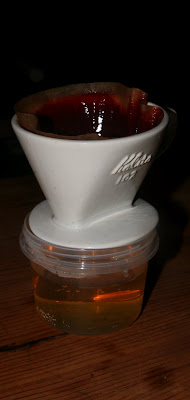
Madder Plants

Boiled madder roots. Note that the outside skin of the root is pigment rich not the tough sinewy inner core.

Madder pigment settling to the bottom. Repeat this several times to neutralize the dye bath.

Filtering the sediment with a coffee filter.

The final madder dye pigment ready to be refrigerated.
Madder, akane '茜' is the root that produces alizarin http://en.wikipedia.org/wiki/Alizarin the only completely light fast and stable red dye. Every brilliant red color on cloth found anywhere in the world through out history up until 1860ish was made from this root. Think of deep red Turkish and Persian carpets, Indian print cloth, red colored tartans etc. The Japanese version grows wildly around Fujino.
Here is the wiki link for a quick read on madder. http://en.wikipedia.org/wiki/Rubia
Keeping it short...bring to a boil 100 grams of the roots in 2 liters of water, turn down the heat and simmer for twenty minutes. Remove the roots and filter the dye liquid through a medium mesh. Repeat the boil with another 2 liters of water. The roots can be used again and again to get paler shaded of pink on silk and wool. Making an extract you want the real dark stuff from the initial two boils.
Combine the two dye baths from the first and second boil. Add 10 grams of creme of tarter or the equivalent amount of aluminum mordant. The pH will be around 3. Use full spectrum pH paper to test. To neutralize the pH to 7 pour in ash alkaline until the mixture clouds up. (Creme of Tarter naturally clouds up when neutralized.) Pour the mixture into jars and let settle. Madder settles in about an hour. Remove the clear liquid and add more water to make sure the mixture is pure and neutralized. Repeat this three to four times.
Finally remove the clear water and pour the sediment into a coffee filter. You want the paste left in the filter. Scoop this out and put it in jar and keep refrigerated, It should keep for months if not years. This red pigment can be used as a stable paint with some binder on cloth or paper wood etc.
Madder has a long history and there are more than a few ways to extract the dye to get clear and deep colors. Another blog.
Sorry I was so cheap with lifted photos of sarasa on yesterday's blog. Here are a few from the kitchen today.

Left: Onion skins and cochineal. Middle: madder. Right (Yamaguchi san cut this stencil): combination. These are not finished yet. When it gets warmer they will get a background or accent color of indigo.







